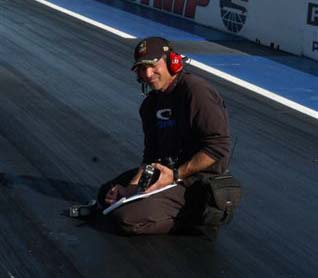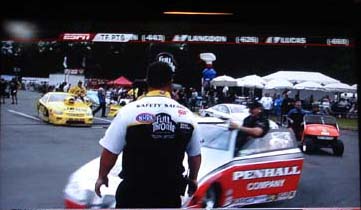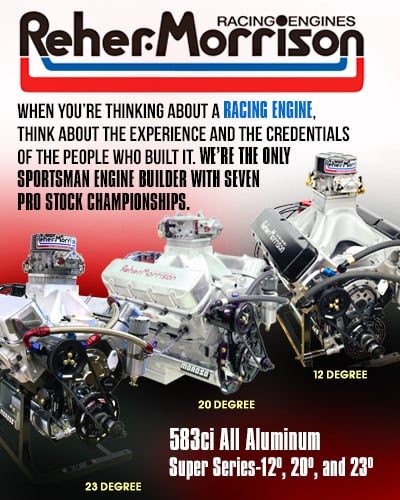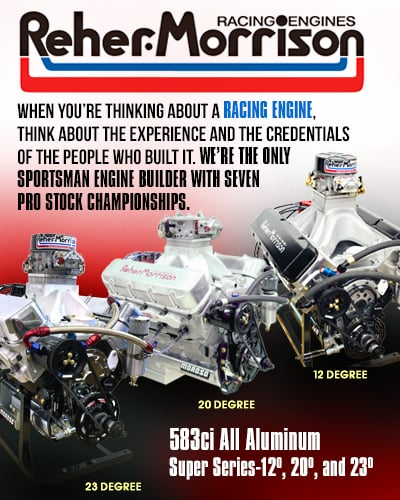SEATTLE PS QUESTIONS MAY NEVER BE ANSWERED
Fri, 2010-07-16 17:00
The drag racing world may never know what transpired during the first round of Pro Stock eliminations at the recently completed NHRA Northwest Nationals in Seattle, but new facts have come to light which may lead to a logical explanation. However, the explanation may still be a guess as to what transpired forcing various Pro Stock racers to verbally lash the sanctioning body alleging a lack of track preparation.
At issue is whether the NHRA prepped the track before the Pro Stockers ran their opening round. What is not at issue is the difference in opinion between the drivers and the race officials.
“We have a huge discrepancy in what us as Pro Stock drivers and crew chiefs need in a racing surface and what the NHRA believes we need in a racing surface,” Pro Stock racer Greg Anderson told ESPN on Sunday afternoon. “They prep it in the way they do for the fuel cars – they run 1,000 feet. We run quarter-mile. They [NHRA] go out there and decide the track doesn’t need any extra glue for the Pro Stock cars. That’s 100-percent wrong. We preach it. We preach it. These cars have to have glue all the way to the quarter-mile. That was skipped today.” The drag racing world may never know what transpired during the first round of Pro Stock eliminations at the recently completed NHRA Northwest Nationals in Seattle, but new facts have come to light which may lead to a logical explanation. However, the explanation may still be a guess as to what transpired forcing various Pro Stock racers to verbally lash the sanctioning body alleging a lack of track preparation.
The drag racing world may never know what transpired during the first round of Pro Stock eliminations at the recently completed NHRA Northwest Nationals in Seattle, but new facts have come to light which may lead to a logical explanation. However, the explanation may still be a guess as to what transpired forcing various Pro Stock racers to verbally lash the sanctioning body alleging a lack of track preparation.
At issue is whether the NHRA prepped the track before the Pro Stockers ran their opening round. What is not at issue is the difference in opinion between the drivers and the race officials.
“We have a huge discrepancy in what us as Pro Stock drivers and crew chiefs need in a racing surface and what the NHRA believes we need in a racing surface,” Pro Stock racer Greg Anderson told ESPN on Sunday afternoon. “They prep it in the way they do for the fuel cars – they run 1,000 feet. We run quarter-mile. They [NHRA] go out there and decide the track doesn’t need any extra glue for the Pro Stock cars. That’s 100-percent wrong. We preach it. We preach it. These cars have to have glue all the way to the quarter-mile. That was skipped today.”
Anderson’s assessment was both right and wrong.
The NHRA, by their admission, didn’t spray the track immediately before the Pro Stock cars ran. But, they did, according to the NHRA’s Dan Olson, spray the track.
One by one, in the media, various Pro Stock drivers alleged the NHRA didn’t prepare a safe racing surface.
“That is not the truth,” Olson responded adamantly.
Olson, NHRA Liaison to Nitro racing, charged with the task of track prep added, “We sprayed the track at approximately 10:20 in the morning and went wall to wall.”
Wall-to-wall spray, according to Olson, is exactly as it sounds; the procedure of spraying each lane from the guard wall to the centerline.
“We made three passes,” said Olson, of the traction compound application. “We spray the track every morning before we start Sunday eliminations.”
Olson pointed out his team sprayed from 40 feet behind the starting line to 1350 feet on Sunday morning.

“We sprayed it slow on purpose so we could get through all of first round before we needed to address the first round of eliminations,” Olson explained. “Normally, we can make the spray last through an entire round on Sundays.”
While there are those who will discount Olson’s testimony as toeing the company line, Lanny Miglizzi, a noted track data technician, confirmed the NHRA did spray the track on Sunday morning.
If anyone should know, it’s Miglizzi.
Miglizzi keeps a detailed record on when the NHRA sprays traction compound on the racing surface because, as he puts it, “that’s my job to record that kind of information.”
According to Miglizzi’s records, in three of the four qualifying sessions – the NHRA sprayed traction compound on the racing surface before Pro Stock. On Friday, the NHRA sprayed before Competition eliminator and then went into Pro Stock. This was the only time the track wasn’t sprayed directly before the Pro Stockers ran.
On Sunday, Miglizzi confirmed the NHRA sprayed the racing surface before all of professional eliminations began and didn’t spray again until the second round.
So why didn’t the NHRA spray before the Pro Stockers ran the first time?
Olson told Attitude’s CompetitionPlus.com that he and two of his trackside observers met after the Pro Stock controversy transpired.

“We have those guys trackside to keep an eye on track conditions as far as needing spray or no spray, or if it’s dry,” noted Olson. “We met at the transition [between concrete and asphalt] and within ten seconds we were all walking out of our shoes. That’s how tacky it was at the time out there.”
The issue Pro Stock racer Allen Johnson said is that Olson’s team deviated from their ritual from the previous days and therein is the problem.
“They didn’t prep the track as they had all weekend,” Johnson alleged. “They didn’t spray it before we ran and they usually do it for both. They did neither. The track has been awesome all weekends, no gripes there. They just changed their track prep method.”
And for Anderson, better coordination with the racers, can and will go a long way.
“Until we get on the same page with the NHRA and they realize what we need as Pro Stock cars, we're going to wreck cars,” Anderson cautioned. “It was an absolute miracle we didn't crash one of the first four cars down that race track. Absolutely out of control that last eighth-mile. There's no reason for that. The race track surface didn't get bad overnight. It's how it was prepped or lack of prep.”
Miglizzi understands why the NHRA didn’t apply any more traction compound.
In an effort to better gauge the level of spray being applied to the racing surface, Miglizzi employs the use of a radar gun to measure the speed in which the compound is being applied. Miglizzi remembers on Sunday, his radar gun, which doesn’t pick up a speed under 10 miles per hour, as measuring considerably slower than usual. He estimates the traction application unit traveling at six miles per hour.
“They were going slow,” Miglizzi recalled. “You can tell if it covered it barely or plenty and in this case, it was plenty. I also use my feet to gauge, the note I made was that it was slow on the spray, stickier than normal. I provide this information to my teams.”
 Miglizzi was taken aback by the allegations the track wasn’t sprayed.
Miglizzi was taken aback by the allegations the track wasn’t sprayed.
“I thought to myself, No way,” admitted Miglizzi. “I thought there had to be something else out there. The dip … the groove, but there was definitely not a lack of spray.”
Miglizzi definitely doesn’t discount what the Pro Stock racers felt and believes they felt exactly what they claimed.
“I don’t doubt it one bit,” Miglizzi said. “I have worked long enough with those guys to know whatever problem they said they had - they had. The track was definitely sprayed and only 16 pairs or less ran. So I can honestly say that I’m confused at what transpired.”
The theories of what went wrong, according to the Pro Stock drivers, range from moisture in the air, considering the morning began considerably cooler, to a possible build up of clutch dust from the fuel cars.
“There was some moisture early in the morning, but that went away as we went along,” Miglizzi said. “It’s usually not a clutch dust issue. Could there have been more than usual? Yes, it was better than normal conditions but by third or fourth gear it shouldn’t have been an issue.”
However, for racer Ron Krisher, who was in the second pair of cars and still ran a 6.62, the ride was enough to convince him something was wrong. He took offense to NHRA VP of Operations Graham Light’s unbending stance towards the Pro Stockers and the track.
“I wish he'd come look at my [computer] graph,” Krisher said. “He'd understand. There is no racetrack from third gear to the end. None. Zero.”
Using his experience as a determining factor, Miglizzi isn’t so sure he wouldn’t have made the same decision the NHRA did in not spraying again before Pro Stock, based on what he witnessed before eliminations.
“Standing there before the race, I wasn’t thinking it needed more spray,” Miglizzi said. “I was thinking, let’s go – time for Pro Stock. I wasn’t surprised when they didn’t spray. The amount applied before the race should have been enough. However, if they would have stopped and sprayed again, I wouldn’t have been surprised either.”

Another theory is the infamous left lane dip at Pacific Raceways. The dip begins at 698 feet and ends at approximately 744 feet. This is a huge factor for Pro Stockers. The right lane has a smaller dip in the same approximate area.
But, this leads to the question, why didn’t the dip affect the cars in qualifying?
“When you have a 130 degree track, you have less clutch in it,” Miglizzi confirmed. “At 85 – 90 degrees, you have a lot more in it. But, with a Pro Stocker, you have no spoiler in it, also.”
Even as a seasoned track prep expert, Miglizzi is still scratching his head.
“We have a big question about what really happened out there,” Miglizzi surmised.
And in compiling the facts, this is a question which may never be answered to the satisfaction of anyone involved.
At issue is whether the NHRA prepped the track before the Pro Stockers ran their opening round. What is not at issue is the difference in opinion between the drivers and the race officials.
“We have a huge discrepancy in what us as Pro Stock drivers and crew chiefs need in a racing surface and what the NHRA believes we need in a racing surface,” Pro Stock racer Greg Anderson told ESPN on Sunday afternoon. “They prep it in the way they do for the fuel cars – they run 1,000 feet. We run quarter-mile. They [NHRA] go out there and decide the track doesn’t need any extra glue for the Pro Stock cars. That’s 100-percent wrong. We preach it. We preach it. These cars have to have glue all the way to the quarter-mile. That was skipped today.”

Dan Olson, in charge of NHRA's track prep, says those allegations by the Pro Stock racers that the track wasn't prepped -- are false. If anything, Olson believes, the track was prepped heavier than usual. [Auto Imagery]
At issue is whether the NHRA prepped the track before the Pro Stockers ran their opening round. What is not at issue is the difference in opinion between the drivers and the race officials.
“We have a huge discrepancy in what us as Pro Stock drivers and crew chiefs need in a racing surface and what the NHRA believes we need in a racing surface,” Pro Stock racer Greg Anderson told ESPN on Sunday afternoon. “They prep it in the way they do for the fuel cars – they run 1,000 feet. We run quarter-mile. They [NHRA] go out there and decide the track doesn’t need any extra glue for the Pro Stock cars. That’s 100-percent wrong. We preach it. We preach it. These cars have to have glue all the way to the quarter-mile. That was skipped today.”
Anderson’s assessment was both right and wrong.
The NHRA, by their admission, didn’t spray the track immediately before the Pro Stock cars ran. But, they did, according to the NHRA’s Dan Olson, spray the track.
One by one, in the media, various Pro Stock drivers alleged the NHRA didn’t prepare a safe racing surface.
“That is not the truth,” Olson responded adamantly.
Olson, NHRA Liaison to Nitro racing, charged with the task of track prep added, “We sprayed the track at approximately 10:20 in the morning and went wall to wall.”
Wall-to-wall spray, according to Olson, is exactly as it sounds; the procedure of spraying each lane from the guard wall to the centerline.
“We made three passes,” said Olson, of the traction compound application. “We spray the track every morning before we start Sunday eliminations.”
Olson pointed out his team sprayed from 40 feet behind the starting line to 1350 feet on Sunday morning.

Lanny Miglizzi, a traction prep specialist, witnessed the NHRA spray the track before the start of eliminations. However, the track wasn't sprayed before Pro Stock ran causing a delay in the first round of eliminations.
“We sprayed it slow on purpose so we could get through all of first round before we needed to address the first round of eliminations,” Olson explained. “Normally, we can make the spray last through an entire round on Sundays.”
While there are those who will discount Olson’s testimony as toeing the company line, Lanny Miglizzi, a noted track data technician, confirmed the NHRA did spray the track on Sunday morning.
If anyone should know, it’s Miglizzi.
Miglizzi keeps a detailed record on when the NHRA sprays traction compound on the racing surface because, as he puts it, “that’s my job to record that kind of information.”
According to Miglizzi’s records, in three of the four qualifying sessions – the NHRA sprayed traction compound on the racing surface before Pro Stock. On Friday, the NHRA sprayed before Competition eliminator and then went into Pro Stock. This was the only time the track wasn’t sprayed directly before the Pro Stockers ran.
On Sunday, Miglizzi confirmed the NHRA sprayed the racing surface before all of professional eliminations began and didn’t spray again until the second round.
So why didn’t the NHRA spray before the Pro Stockers ran the first time?
Olson told Attitude’s CompetitionPlus.com that he and two of his trackside observers met after the Pro Stock controversy transpired.

The was the first round race which started a firestorm of controversy. For any NHRA official who says traction was optimal in this race, Ron Krisher [near lane] offers up his computer graph that there was no traction despite his 6.62 elapsed time. [via espn]
“We have those guys trackside to keep an eye on track conditions as far as needing spray or no spray, or if it’s dry,” noted Olson. “We met at the transition [between concrete and asphalt] and within ten seconds we were all walking out of our shoes. That’s how tacky it was at the time out there.”
The issue Pro Stock racer Allen Johnson said is that Olson’s team deviated from their ritual from the previous days and therein is the problem.
“They didn’t prep the track as they had all weekend,” Johnson alleged. “They didn’t spray it before we ran and they usually do it for both. They did neither. The track has been awesome all weekends, no gripes there. They just changed their track prep method.”
And for Anderson, better coordination with the racers, can and will go a long way.
“Until we get on the same page with the NHRA and they realize what we need as Pro Stock cars, we're going to wreck cars,” Anderson cautioned. “It was an absolute miracle we didn't crash one of the first four cars down that race track. Absolutely out of control that last eighth-mile. There's no reason for that. The race track surface didn't get bad overnight. It's how it was prepped or lack of prep.”
Miglizzi understands why the NHRA didn’t apply any more traction compound.
In an effort to better gauge the level of spray being applied to the racing surface, Miglizzi employs the use of a radar gun to measure the speed in which the compound is being applied. Miglizzi remembers on Sunday, his radar gun, which doesn’t pick up a speed under 10 miles per hour, as measuring considerably slower than usual. He estimates the traction application unit traveling at six miles per hour.
“They were going slow,” Miglizzi recalled. “You can tell if it covered it barely or plenty and in this case, it was plenty. I also use my feet to gauge, the note I made was that it was slow on the spray, stickier than normal. I provide this information to my teams.”

Pro Stock driver Warren Johnson spoke out on ESPN about the track prep, leading to a suspension of the opening round of the class. [via espn]
“I thought to myself, No way,” admitted Miglizzi. “I thought there had to be something else out there. The dip … the groove, but there was definitely not a lack of spray.”
Miglizzi definitely doesn’t discount what the Pro Stock racers felt and believes they felt exactly what they claimed.
“I don’t doubt it one bit,” Miglizzi said. “I have worked long enough with those guys to know whatever problem they said they had - they had. The track was definitely sprayed and only 16 pairs or less ran. So I can honestly say that I’m confused at what transpired.”
The theories of what went wrong, according to the Pro Stock drivers, range from moisture in the air, considering the morning began considerably cooler, to a possible build up of clutch dust from the fuel cars.
“There was some moisture early in the morning, but that went away as we went along,” Miglizzi said. “It’s usually not a clutch dust issue. Could there have been more than usual? Yes, it was better than normal conditions but by third or fourth gear it shouldn’t have been an issue.”
However, for racer Ron Krisher, who was in the second pair of cars and still ran a 6.62, the ride was enough to convince him something was wrong. He took offense to NHRA VP of Operations Graham Light’s unbending stance towards the Pro Stockers and the track.
“I wish he'd come look at my [computer] graph,” Krisher said. “He'd understand. There is no racetrack from third gear to the end. None. Zero.”
Using his experience as a determining factor, Miglizzi isn’t so sure he wouldn’t have made the same decision the NHRA did in not spraying again before Pro Stock, based on what he witnessed before eliminations.
“Standing there before the race, I wasn’t thinking it needed more spray,” Miglizzi said. “I was thinking, let’s go – time for Pro Stock. I wasn’t surprised when they didn’t spray. The amount applied before the race should have been enough. However, if they would have stopped and sprayed again, I wouldn’t have been surprised either.”

One by one, the Pro Stockers returned to their pits until the track was sprayed again. [via espn]
Another theory is the infamous left lane dip at Pacific Raceways. The dip begins at 698 feet and ends at approximately 744 feet. This is a huge factor for Pro Stockers. The right lane has a smaller dip in the same approximate area.
But, this leads to the question, why didn’t the dip affect the cars in qualifying?
“When you have a 130 degree track, you have less clutch in it,” Miglizzi confirmed. “At 85 – 90 degrees, you have a lot more in it. But, with a Pro Stocker, you have no spoiler in it, also.”
Even as a seasoned track prep expert, Miglizzi is still scratching his head.
“We have a big question about what really happened out there,” Miglizzi surmised.
And in compiling the facts, this is a question which may never be answered to the satisfaction of anyone involved.
Categories:




































